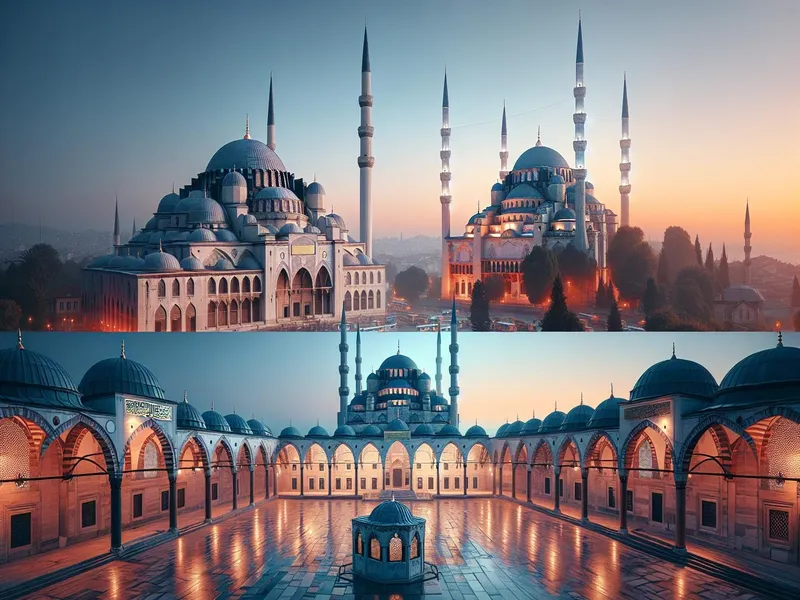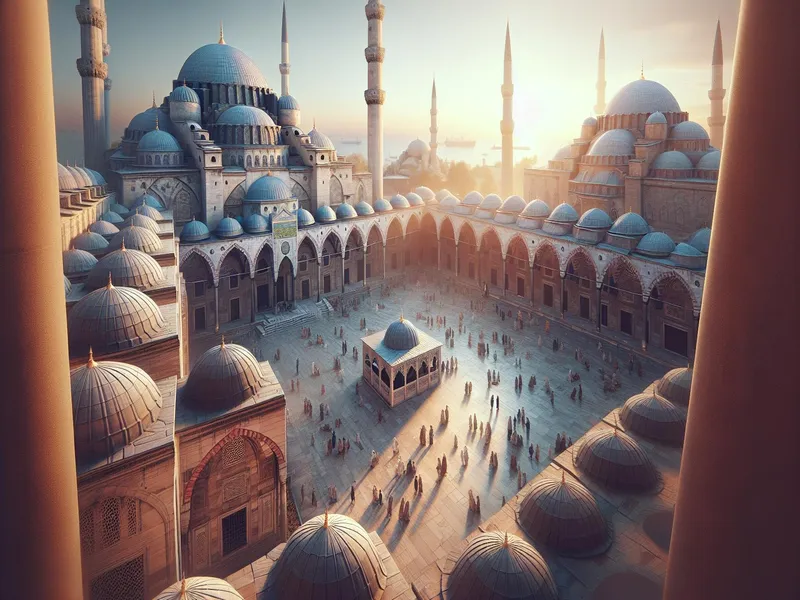the stunning contrasts between Istanbul’s Suleymaniye Mosque and Blue Mosque. Uncover their rich history, unique architecture, and travel tips for backpackers.

Historical Background
When you’re exploring Istanbul, the Suleymaniye Mosque and Blue Mosque are absolute must-visits. Each has a unique history that adds layers to their beauty.
Suleymaniye Mosque
The Suleymaniye Mosque, built in the 16th century, is a masterpiece of Sinan, the chief Ottoman architect. Commissioned by Sultan Suleiman the Magnificent, it’s not just a mosque; it’s an entire complex including schools, a hospital, and even a kitchen that fed thousands daily. The mosque itself stands as an embodiment of Ottoman power and architectural finesse.
Fun Fact: Sinan was so dedicated he lived on-site during construction!
When you step inside, you can almost feel the weight of its history around you—the elegant domes and towering minarets are breathtaking. It’s less crowded than some other sites in Istanbul, giving you space to appreciate its grandeur without elbowing through throngs of tourists.
Blue Mosque
Now let’s talk about the Blue Mosque—this one’s iconic! Built between 1609 and 1616 under Sultan Ahmed I’s rule, it’s known for its stunning blue İznik tiles that line its interior walls. It’s located right opposite Hagia Sophia in Sultanahmet Square—a spot you’ll easily find on any backpacker map ️.
Pro Tip: Visit at dusk when the mosque is beautifully lit against the night sky .
The Blue Mosque isn’t just famous for its beauty; it’s still an active place of worship. This means you’ll see locals coming in for prayers while tourists marvel at its design. Remember to dress modestly (bring a scarf if you’re female) and respect prayer times—trust me, it’s all part of soaking up this rich cultural experience!
Architectural Design

Talking about the architectural design of Suleymaniye Mosque and the Blue Mosque feels like discussing two masterpieces from different chapters of an art book. Each mosque has its own unique charm, so let’s jump into what sets them apart.
Exterior Features
The Suleymaniye Mosque stands proud on one of Istanbul’s seven hills. Designed by Sinan, it’s a grand spectacle with its massive dome and four minarets. The courtyard is expansive, offering a peaceful space to sit and soak in the atmosphere . I remember sitting there with my backpack snugly beside me, just watching the city bustle around this tranquil spot.
The Blue Mosque, or Sultan Ahmed Mosque, is iconic for its six minarets and cascading domes that seem to ripple across the sky . When you stand outside at dusk, it almost feels like you’re part of a painting as the evening light reflects off those famous blue İznik tiles. It’s something straight out of a travel magazine!
| Feature | Suleymaniye Mosque | Blue Mosque |
|---|---|---|
| Minarets | 4 | 6 |
| Designer | Sinan | Sedefkâr Mehmed Ağa |
| Key Material | Stone | Blue İznik Tiles |
Interior Features
Stepping inside these mosques is like stepping into another world.
Inside Suleymaniye, you’ll find vast open spaces filled with natural light thanks to its numerous windows . The interior decoration leans more towards elegance rather than opulence—think intricate calligraphy and subtle tile work. Once, while exploring on a rainy day, I found myself admiring how serene everything felt even though being indoors.
Conversely, Blue Mosque‘s interior is where it truly lives up to its name ! Over 20,000 handmade ceramic tiles cover every surface in various shades of blue—it’s mesmerizing! Imagine lying on your back (well…not literally) and gazing up at this dazzling display—it’s awe-inspiring enough to make even non-architecture buffs appreciate it.
Here’s what makes each interior special:
- Suleymaniye:
- Large central dome
- Elegant simplicity ️
- Abundant natural light ☀️
- Blue Mosque:
- Thousands of blue tiles
- Stained glass windows
- Lavish chandeliers ✨
Cultural Significance

When visiting Istanbul, it’s impossible to miss the cultural weight of its iconic mosques. Let’s jump into how the Suleymaniye Mosque and the Blue Mosque each leave their mark.
Suleymaniye Mosque’s Influence
The Suleymaniye Mosque isn’t just a place of worship; it’s a symbol of Ottoman grandeur. Built in the 16th century by Sinan, the chief Ottoman architect, this mosque reflects the zenith of Ottoman architectural prowess. Imagine standing in a massive complex that once represented Ottoman power—it’s like stepping back into history.
One cool fact: The mosque also serves as a social complex with schools, hospitals, and even a caravanserai (a roadside inn for travelers). When I wandered through its serene courtyards, it felt like time stood still. Fewer tourists visit here compared to the Blue Mosque, making it an ideal spot if you want some peace and quiet.
What you’ll find:
- Architectural finesse: Massive dome, four minarets
- Complexity: Includes educational institutions and healthcare facilities
- Atmosphere: Less crowded, more contemplative space
Blue Mosque’s Influence
On the flip side, there’s no mistaking the Blue Mosque, officially known as Sultan Ahmed Mosque. Built between 1609 and 1616, it’s renowned for its stunning blue İznik tiles that give it its nickname. This mosque is still active today; I remember one evening when I visited at dusk—the play of lights on those tiles was simply breathtaking.
Even though being packed with tourists almost year-round , this doesn’t take away from its spiritual ambiance. It’s a must-see for anyone interested in Islamic art or architecture. My tip? Dress modestly and respect prayer times if you want to soak in every bit of its cultural essence.
- Visual splendor: Over 20,000 blue ceramic tiles
- Architectural uniqueness: Six minarets
- Buzzing activity: Active place of worship with numerous visitors
Visitor Experience
Visiting the Suleymaniye Mosque and the Blue Mosque in Istanbul is like stepping into two different worlds. Both offer unique experiences, but knowing what to expect can make your visit much more enjoyable.
Accessibility
When it comes to getting there, both mosques are pretty accessible. Suleymaniye Mosque sits on one of Istanbul’s seven hills, offering a bit of a climb but nothing too crazy. If you’re backpacking, you’ll appreciate the exercise and the stunning views over the Golden Horn once you get there. Public transport options abound: hop on tram line T1 to Beyazit-Kapalicarsi or Eminonu stations and walk 10-15 minutes uphill.
The Blue Mosque, located in Sultanahmet Square, is super easy to find. You can’t miss its iconic minarets standing tall against the skyline. It’s right next to other major attractions like Hagia Sophia and Topkapi Palace—perfect for an all-in-one day trip! The nearest tram stop is Sultanahmet on line T1, just a 5-minute walk away.
Pro Tip: Wear comfortable shoes! Cobblestone streets and steps are everywhere. And don’t forget about modest dress codes—cover those knees and shoulders!
| Mosque | Closest Tram Stop | Walking Time |
|---|---|---|
| Suleymaniye | Beyazit-Kapalicarsi | 10-15 mins |
| Blue Mosque | Sultanahmet | 5 mins |
Guided Tours
Both mosques offer guided tours that bring their rich history alive with fascinating anecdotes about Ottoman architecture and culture.
At Suleymaniye, I joined a small group tour led by a passionate local historian who shared insider stories about Sinan’s architectural genius. We even got access to some quieter corners of the complex usually missed by solo visitors—a real treat if you’re into history! Tours typically last around an hour and cost between $10-$20 per person.
For the Blue Mosque, free public tours run throughout the day when it’s not prayer time (five times daily). I once joined an afternoon tour that ended at dusk—the blue tiles glowed beautifully under soft lighting as our guide explained their significance in Islamic art ✨ It was magical! These tours generally don’t require prior booking; just show up at designated spots outside.
Here’s what you should pack:
- Modest clothing: Long pants/skirts, long-sleeve tops
- Comfortable shoes: For all that walking!
- Camera: You’ll want photos
- Water bottle: Stay hydrated while exploring
- Guided tours: Great for deeper insights.
- Solo visits: Flexible schedule but might miss out on some hidden gems.
Exploring both the Suleymaniye Mosque and the Blue Mosque offers an enriching glimpse into Istanbul’s storied past and vibrant culture. Each mosque presents a unique architectural marvel that stands as a testament to the Ottoman Empire’s grandeur and artistic brilliance. While the serene atmosphere of the Suleymaniye invites quiet reflection, the bustling charm of the Blue Mosque promises a dynamic cultural experience.
Visiting these iconic landmarks not only deepens one’s appreciation for Islamic architecture but also provides valuable insights into Istanbul’s historical world. Whether it’s the tranquil courtyards of Suleymaniye or the mesmerizing blue tiles of Sultanahmet, both mosques offer unforgettable moments that are sure to leave a lasting impression on any traveler.